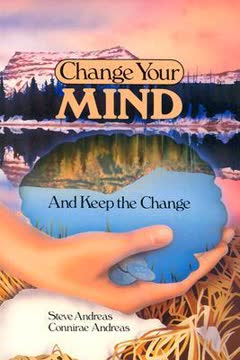Key Takeaways
1. Unlock Your Mind's Code: Submodalities Drive All Experience
The proper place of words in our lives is to help us keep track of experiences, by labeling them and categorizing them.
Beyond words. While words label our experiences, it's the underlying "submodalities"—the fine distinctions in our sensory representations—that truly code meaning and dictate our responses. These are the fundamental building blocks of how our minds organize and interpret reality, far more impactful than the content itself.
Sensory distinctions. Submodalities are the qualities of our internal pictures, sounds, and feelings. For example, a visual image can be:
- Big or small
- Bright or dim
- Close or far
- In color or black-and-white
- Still or a movie
Auditory submodalities include volume, pitch, tempo, and location, while kinesthetic ones involve pressure, temperature, texture, and movement. These subtle differences determine how compelling, important, or real an experience feels.
Change your code. By consciously identifying and adjusting these submodalities, we can rapidly change how we perceive and react to any experience. This "human software" allows us to re-engineer our internal world, transforming problems into resources and limitations into choices, often without needing to delve into the "why" of the problem.
2. Master Your Internal Timeline to Reshape Your Reality
The ways people represent time—past, present, and future—provide the basis for their skills and limitations.
Time's influence. Our internal representation of time profoundly shapes our personality and behavior. Whether someone "lives in the past," "only for today," or "for the future" is determined by how they spatially and qualitatively code past, present, and future experiences in their mind.
Eliciting your timeline. By thinking of a simple, repeated behavior (like brushing teeth) across different time points (five years ago, a week ago, now, a week from now, five years from now), we can uncover the unique submodality differences that distinguish these periods. Common distinctions include:
- Location: Past often to the left, future to the right (or vice-versa).
- Size/Brightness: Distant events may be smaller/dimmer.
- Detail: Future often less detailed, reflecting uncertainty.
- Digital differences: Past in black-and-white, future in color.
Adjusting your timeline. Experimenting with these submodalities can dramatically alter one's time orientation. For instance, making the future closer and brighter can enhance long-range planning, while spreading out a "bunched up" future can reduce stress. This flexibility allows us to optimize our relationship with time, moving past events out of the way when needed, or bringing future goals closer for motivation.
3. The Swish Pattern: Rapidly Transform Unwanted Responses
By changing submodalities in this way, the person's attention is quickly drawn from the cue to the desired self-image by a process called chaining: linking two experiences together.
Behavioral transformation. The Swish Pattern is a powerful technique to change unwanted behaviors or emotional responses by rapidly shifting internal representations. It works by linking a problematic "cue image" to a compelling "desired self-image" using specific submodality changes.
Three core elements:
- Cue Selection: Identify the image that reliably triggers the unwanted behavior (e.g., seeing your hand with a cigarette). It must be dependable and usually associated.
- Desired Self-Image: Create a dissociated, attractive image of "the you with more choices," embodying qualities (e.g., resourceful, confident) rather than specific actions. This image should be uncontextualized to promote generalization.
- Submodality Shifts: Use powerful, simultaneous, and rapid changes in submodalities (e.g., cue goes big/bright to small/dim, self-image goes small/dim to big/bright) to chain the two images.
Key to success. The speed and direction of the swish are crucial; it must be fast and only in one direction (from problem to desired state). Repetition solidifies the change, making the new response automatic. This pattern is highly ecological because the desired self-image, often generated unconsciously, provides flexible, resourceful alternatives.
4. Shift Your Criteria: Realign What Truly Matters to You
When you work with beliefs, quite often you change a limiting belief to its opposite... However, when you're dealing with a person's criteria, you very seldom want to change them totally to their opposites.
Values as drivers. Criteria are our internal standards for evaluation—what we do things for (e.g., "fun," "success," "safety"). They are nominalizations that generalize across contexts and profoundly influence our motivation and behavior. Problems arise when criteria are misaligned, either too important or not important enough.
Eliciting criteria hierarchy. To adjust criteria, first identify a hierarchy of what's important. This is done by asking about trivial behaviors and progressively negating them in cumulative contexts to uncover successively higher-valued criteria. For example:
- "Why wouldn't you do the dishes?" -> "Saving time."
- "What would make you do them anyway?" -> "Starting with a neutral impression."
- "What would make you not do them then?" -> "Excellence of cooking."
Adjusting importance. Once a hierarchy is established, identify the submodalities that code importance (e.g., closeness, height, size, brightness). Then, slowly adjust the problematic criterion's submodalities to its desired level of importance. This is an analogue shift, fine-tuning rather than reversing, ensuring ecological balance and preventing unintended consequences.
5. Eliminate Compulsions: Break Unwanted Habits Instantly
The compulsion blowout allows you to eliminate even very intense, strong compulsions—often in minutes—so it's a very powerful pattern.
Breaking the cycle. Compulsions are strong, often irrational urges (e.g., eating chocolate, checking phones) that feel irresistible. The Compulsion Blowout is a rapid, powerful technique to sever the connection between the internal representation of the compulsive object and the feeling of compulsion.
The four-step sequence:
- Representation: An internal image, sound, or feeling of the compulsive object.
- Submodality Distortion: A specific analogue submodality (the "driver") intensifies the representation (e.g., image leaps out, sound gets louder).
- Feeling of Compulsion: The irresistible kinesthetic urge.
- Compulsive Behavior: The action taken to satisfy the urge.
The blowout process. Identify the driving submodality (e.g., focus, size, closeness). Then, rapidly and repeatedly intensify this driver beyond its normal range. For example, if size drives it, make the image bigger and bigger, faster and faster, until it goes "over threshold" and "pops." This breaks the brain's recognition of the object as something to be compelled by, often making it seem ridiculous or unappealing.
Ecology and follow-up. This pattern is irreversible for the specific compulsion, so careful ecology checks are vital. Since it only breaks a compulsion, it's crucial to follow up with a Swish Pattern to install new, resourceful choices that fulfill any positive intent the compulsion might have served (e.g., eating for comfort).
6. Cross the "Last Straw" Threshold: End Destructive Patterns Permanently
When people go over this kind of threshold, it's as if they say, "Never again" to something.
Breaking point. The "Last Straw" pattern leverages the natural human tendency to reach a breaking point with undesirable situations or behaviors. It's for when someone has endured repeated problems and finally declares, "That's it! Never again!"
Three stages of the pattern:
- Reaching Threshold: Accumulate representations of the unpleasantness of continuing the behavior. This often involves stacking multiple past examples (e.g., arguments, negative consequences) or projecting them into the future, intensifying the negative feelings.
- Crossing Threshold: A digital submodality shift occurs (e.g., a picture shatters, a loud "No!" voice, a cord breaks). This marks the irreversible decision to stop the behavior.
- New Alternative: A clear representation of a new, desirable life or behavior emerges, providing a positive direction forward.
Irreversible change. This pattern is typically irreversible, making careful ecology checks essential. It's particularly useful for breaking long-standing destructive habits, relationships, or job situations where a person feels trapped. The key is to make the consequences of continuing the unwanted behavior subjectively so compelling that the brain is forced to create a new path.
7. Cultivate Internal Reference: Decide for Yourself, Wisely
Internal reference means that / decide what's right, wrong, and so on. I may take in lots of information from other people or from the environment, but I am the one who decides about it.
Who decides? Internal/External Reference describes how individuals make decisions and evaluations. An "external reference" person relies on others' opinions or external rules, while an "internal reference" person processes external information but ultimately decides for themselves.
Submodality differences:
- External Reference: Often characterized by big, bright, close pictures of what "experts" say, leaving little room for alternative thoughts. Images may be elevated.
- Internal Reference: Involves generating multiple alternative representations (pictures, sounds, feelings) and comparing them, often with a dialogue or internal testing. Images are typically farther away, allowing for perspective.
Shifting reference. To cultivate a stronger internal reference, one can consciously shrink, dim, or move away the external "expert" images, creating space for personal evaluation and alternative generation. Conversely, to become more receptive to feedback (without becoming externally referenced), one can make others' ideas compelling enough to consider, while still maintaining personal judgment.
8. Respond to Criticism Resourcefully: Feedback, Not Failure
There is no such thing as failure, only feedback.
Beyond emotional reactions. Most people react to criticism with immediate negative feelings or outright rejection, missing valuable feedback. This strategy teaches a systematic way to process criticism objectively, extracting useful information without emotional distress.
The 8-step strategy:
- Dissociate from criticism: See yourself being criticized from a distance (e.g., behind plexiglass, in black-and-white).
- Represent criticism: Make a dissociated movie of the criticism's content.
- Gather information: If vague, ask for specifics until a clear representation is formed.
- Evaluate criticism: Compare the criticism's representation with your own best information about the situation (e.g., re-run your memories, consider other viewpoints).
- Decide on a response: Choose an appropriate, resourceful response (e.g., "Thank you," apology, clarification).
- Consider future behavior: Decide if you want to adjust your future actions based on the feedback, and future-pace new behaviors.
- Repetition: Rehearse the strategy with different types of criticism to generalize the skill.
- Reassociate: Integrate the learned strategy back into yourself, making it automatic and unconscious.
Internalizing feedback. This strategy installs a powerful internal reference mechanism, allowing individuals to remain resourceful, evaluate feedback objectively, and make conscious choices for future improvement, transforming criticism into a valuable learning opportunity.
9. Access and Redesign Kinesthetic States: Control Your Inner Physiology
When you chunk your experience down small enough, you can change state very easily.
The recipe for states. This technique provides a precise "recipe" for accessing and redesigning any powerful kinesthetic state, including drug states, relaxation, or excitement. It works by identifying the specific, small-chunk physiological sensations that occur in sequence as one enters a particular state.
Elicitation and redesign:
- Kinesthetic Sequence: Break down the experience of entering the state into a precise sequence of primary kinesthetic sensations (e.g., lightness, warmth, tingling, pressure, spreading). Avoid evaluative labels like "excitement."
- Other Submodality Shifts: Identify accompanying visual and auditory changes that occur at each stage of the kinesthetic sequence.
- Adjust Submodalities: Experiment with altering the qualities of these sensations (e.g., making warmth cooler, adding sparkle to visuals) to enhance or modify the state.
- Adjust Sequence: Change the order of the sensations to find a more powerful or desirable experience.
- Compress Sequence: Speed up the entire sequence to intensify the state, making it accessible in seconds.
Beyond drugs. This method offers a way to gain voluntary control over powerful internal states, providing the benefits of drug states (e.g., pain relief, relaxation) without the negative side effects or loss of control. It's a powerful tool for self-regulation and can be applied to enhance any kinesthetic resource.
10. Brief Interventions: Quick Tools for Profound Change
Although this is one of the simplest submodality methods, the applications seem endless— both for helping individuals change, and for modeling the structure of excellence.
Targeted transformations. Beyond the major patterns, several "Briefest Therapy" interventions leverage submodalities for rapid, specific changes, often with profound impact. These are quick, direct applications of NLP principles.
Key brief interventions:
- Mapping Across: Identify submodality differences between a problem state and a resource state, then apply the resource submodalities to the problem state to transform it (e.g., lethargy to motivation, allergy to tolerance).
- Literal Reframing: Physically place a problematic visual image within a literal frame (e.g., a baroque gold frame) to create emotional distance and a more objective perspective, anchoring a lighter feeling.
- Fall Down Laughing: Imagine telling a wise, trusted friend about a problem, and they "fall down laughing" uncontrollably. This dissociates you from the problem's seriousness, making it harder to take seriously again.
- Godiva Chocolate Pattern: To create motivation for a task, see the task picture with a "motivation picture" (e.g., chocolate) behind it. Rapidly open and close a hole in the task picture to reveal the motivation picture, linking the desired feelings to the task.
- Disruption (Crazing): For useless, intrusive images (e.g., horror movie scenes), imagine the image shattering like tempered glass into thousands of tiny granules, creating amnesia for the disturbing content.
Precision and ecology. These interventions highlight the precision of submodality work. While powerful and fast, careful ecology checks are always necessary to ensure the changes are beneficial and align with the individual's overall well-being, preventing unintended consequences.
Last updated:
Review Summary
Change Your Mind--And Keep the Change receives mixed reviews, with an average rating of 3.94 out of 5. Some readers find it disappointing, citing a lack of instructive content and an overreliance on transcripts. Others appreciate its potential for personal transformation but note that it may be challenging to read. The book's content is described as good but potentially geared towards experts in NLP (Neuro-Linguistic Programming). Despite the criticisms, some readers view it as future-changing programming, highlighting its potential impact on personal development.
Similar Books
Download PDF
Download EPUB
.epub digital book format is ideal for reading ebooks on phones, tablets, and e-readers.








